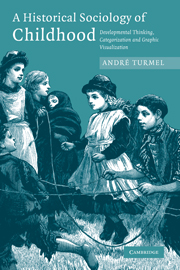 A Historical Sociology of Childhood
A Historical Sociology of Childhood Book contents
- Frontmatter
- Contents
- List of illustrations
- Acknowledgements
- Introduction
- 1 Children in the collective
- 2 Graphs, charts and tabulations: the textual inscription of children
- 3 Social technologies: regulation and resistance
- 4 The normal child: translation and circulation
- 5 Developmental thinking as a cognitive form
- Conclusion
- Appendix
- Bibliography
- Index
4 - The normal child: translation and circulation
Published online by Cambridge University Press: 22 September 2009
- Frontmatter
- Contents
- List of illustrations
- Acknowledgements
- Introduction
- 1 Children in the collective
- 2 Graphs, charts and tabulations: the textual inscription of children
- 3 Social technologies: regulation and resistance
- 4 The normal child: translation and circulation
- 5 Developmental thinking as a cognitive form
- Conclusion
- Appendix
- Bibliography
- Index
Summary
A child is recognized as normal when it is classified as such, different in most features from anomalous children, and as standards of development are identified, implemented and generalized in the collective. Standards of development or normalcy – it remains to be seen if and how the two are equivalent, thus, substitutable one for the other; this chapter will investigate the question. The turn of the twentieth century's enthusiasm for normalcy – and for standardization (Adams 1934) – could not bypass the childhood collective for it was in the process of becoming a distinct entity within the national population; public authorities expressed concerns about all but few children's general condition. Developmental standards, which are produced at once and the same time by the activity of and by the technologies of regulation, bring about three different forms of normalcy.
Collection of data, measurement and classification: a new way of thinking, characterized by numerical facts, statistics, probability, mean, dispersion and correlation, seized hold of population studies. These new forces turned up in the childhood collective. Statistical reason, both in its cognitive and administrative lineaments, introduces consistency and regularity in the investigation of the child. This way of reading reality pertained to childhood as well: the institutional knowledge of children started to grasp its object in terms of statistical laws and probability. In this context, the normal met probability, mean etc. and overlapped with these notions.
- Type
- Chapter
- Information
- A Historical Sociology of ChildhoodDevelopmental Thinking, Categorization and Graphic Visualization, pp. 182 - 247Publisher: Cambridge University PressPrint publication year: 2008


